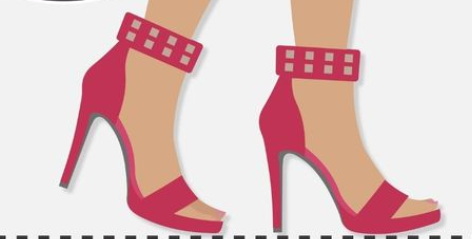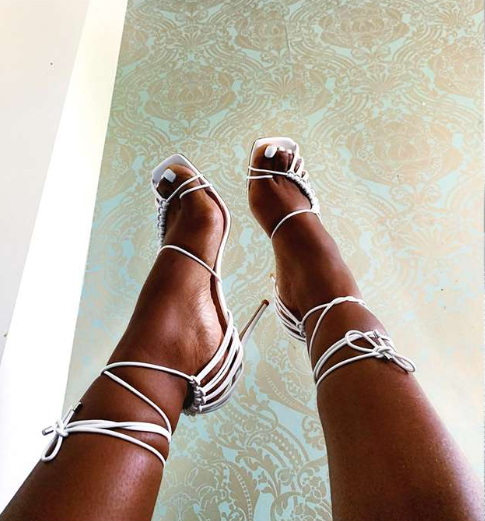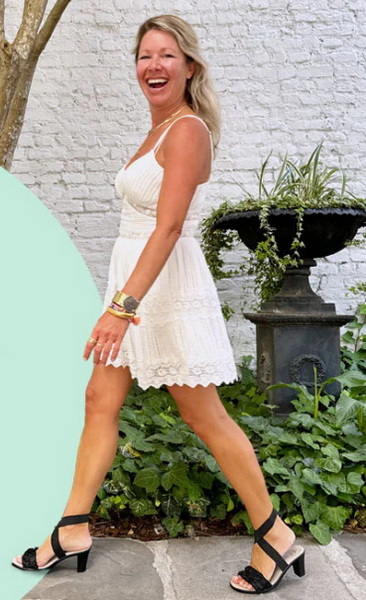Content Menu
● Understanding the Anatomy of High Heels
● The Benefits of Wearing Heels
● Techniques for Walking in Heels
>> 1. Start with the Right Fit
>> 2. Master the Heel-to-Toe Technique
>> 3. Maintain Good Posture
>> 4. Practice Walking Straight
>> 5. Break Them In
● Dealing with Discomfort
>> 1. Stretch Regularly
>> 2. Choose Comfortable Styles
>> 3. Use Foot Care Products
● Real-Life Experiences
● Conclusion
● FAQ
>> 1. How do I choose the right heel height?
>> 2. What should I do if my feet hurt after wearing heels?
>> 3. Can I wear heels every day?
>> 4. How do I prevent blisters when wearing new shoes?
>> 5. What are some alternatives to high heels?
● Citations:
Walking in high heels is often seen as a symbol of elegance and femininity. However, many women struggle with the discomfort and challenges that come with wearing them for extended periods. This article explores the techniques, tips, and tricks that can help women walk gracefully in heels all day long, while also addressing the physical challenges associated with this fashionable footwear.

Understanding the Anatomy of High Heels
High heels come in various styles, from stilettos to block heels. Each type affects how a woman walks and distributes her weight. The key components include:
- Heel Height: Taller heels can create more strain on the feet and back.
- Toe Box: A narrow toe box can lead to discomfort and blisters.
- Arch Support: Good arch support can prevent foot fatigue.
The Benefits of Wearing Heels
Despite the discomfort, many women choose to wear heels for several reasons:
- Enhanced Posture: Heels can encourage better posture by aligning the spine.
- Increased Confidence: The added height can boost self-esteem and presence.
- Fashion Statement: Heels often complement outfits, making them a popular choice for formal occasions.
Techniques for Walking in Heels
Walking in heels requires practice and technique. Here are some essential tips to master the art of walking gracefully:
1. Start with the Right Fit
The most crucial aspect of wearing heels is ensuring they fit properly. Shoes that are too tight or too loose can cause blisters and instability.
- Try Before You Buy: Always walk around in the shoes before purchasing.
- Consider Inserts: If your shoes are slightly loose, consider using gel inserts for a better fit.
2. Master the Heel-to-Toe Technique
The way you place your foot is vital for maintaining balance and grace.
- Heel First: Always place your heel down first, followed by your toe. This technique helps distribute your weight evenly.
- Small Steps: Take shorter strides to maintain control and stability.
3. Maintain Good Posture
Posture plays a significant role in how you carry yourself in heels.
- Engage Your Core: Keeping your core muscles engaged helps stabilize your body.
- Lean Slightly Back: This helps counterbalance the forward tilt that high heels can create.
4. Practice Walking Straight
Visualizing a straight line can help you walk more gracefully.
- Look Ahead: Focus on a point in front of you rather than down at your feet.
- Avoid Crossing Your Feet: Keep your steps aligned to avoid stumbling.
5. Break Them In
New heels can be uncomfortable; breaking them in gradually helps ease this process.
- Wear at Home: Start by wearing them around the house for short periods.
- Gradually Increase Time: Slowly increase the duration you wear them each day.

Dealing with Discomfort
Even with proper techniques, discomfort can still arise from prolonged wear. Here are some strategies to alleviate pain:
1. Stretch Regularly
Stretching your feet and legs can help relieve tension after wearing heels.
- Calf Stretches: Stand facing a wall, place one foot behind you, and lean forward to stretch the calf muscle.
2. Choose Comfortable Styles
Opting for styles that offer more support can make a significant difference.
| Style | Comfort Level | Description |
| Stilettos | Low | Elegant but offers little support |
| Block Heels | Medium | Provides more stability due to wider base |
| Wedges | High | Distributes weight evenly across the foot |
3. Use Foot Care Products
Investing in foot care products can enhance comfort levels:
- Gel Pads: These provide cushioning where it's needed most.
- Blister Prevention Stick: Apply this to areas prone to friction before wearing heels.
Real-Life Experiences
Many women share their journeys of learning to wear high heels comfortably. For instance, one woman documented her experience of wearing high heels every day for a week, noting both challenges and triumphs along the way. She found that while her feet were sore at times, she also felt more confident and empowered when dressed up[5][8].
Conclusion
Walking in heels all day is an art that combines technique, comfort, and confidence. With practice and the right strategies, women can enjoy the elegance of high heels without sacrificing comfort or stability. By focusing on proper fit, mastering walking techniques, maintaining good posture, and addressing discomfort proactively, any woman can strut confidently in her favorite pair of heels.

FAQ
1. How do I choose the right heel height?
Choosing the right heel height depends on your comfort level and experience with heels. Beginners might start with lower heights (1-2 inches) before progressing to higher styles (3 inches or more).
2. What should I do if my feet hurt after wearing heels?
If your feet hurt after wearing heels, try stretching your calves and feet afterward. Consider using gel inserts or switching to lower shoes when possible.
3. Can I wear heels every day?
Yes, many women wear heels daily; however, it's essential to choose comfortable styles and take breaks when needed to prevent foot fatigue.
4. How do I prevent blisters when wearing new shoes?
To prevent blisters, break in new shoes gradually by wearing them for short periods at home. Use blister prevention products as needed.
5. What are some alternatives to high heels?
Alternatives include block heels, wedges, or stylish flats that provide comfort while still looking fashionable.
Citations:
[1] https://www.whowhatwear.com/uk/how-to-walk-in-heels
[2] https://charlestonshoeco.com/blogs/charleston-shoe-company-blog/how-to-walk-in-heels
[3] https://hhplace.org/topic/25301-part-4-my-first-year-in-stilettos/
[4] https://unsplash.com/s/photos/heels
[5] https://www.youtube.com/watch?v=_7Q26Jv4_Ww
[6] https://www.istockphoto.com/de/bot-wall?returnUrl=%2Fde%2Fvideos%2Fwoman-walking-in-high-heels
[7] https://www.seventeen.com/fashion/style-advice/a42866664/how-to-walk-in-high-heels-pumps/
[8] https://capsulenz.com/featured/heels-for-a-week/
[9] https://unsplash.com/s/photos/high-heels
[10] https://www.youtube.com/watch?v=Vf3KQIvHmSk

















